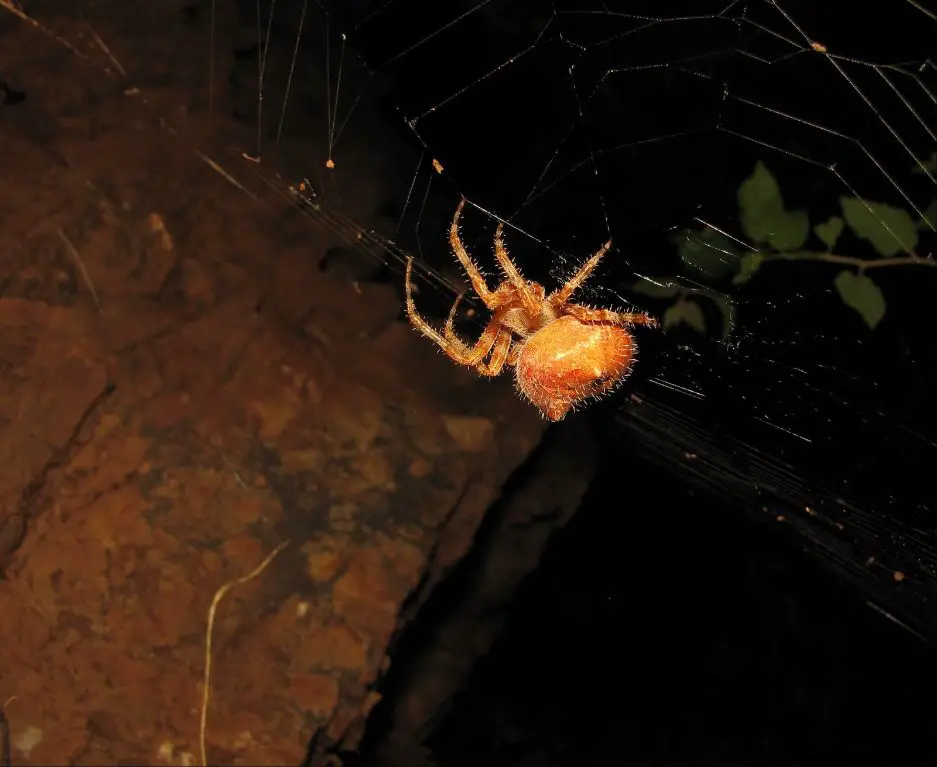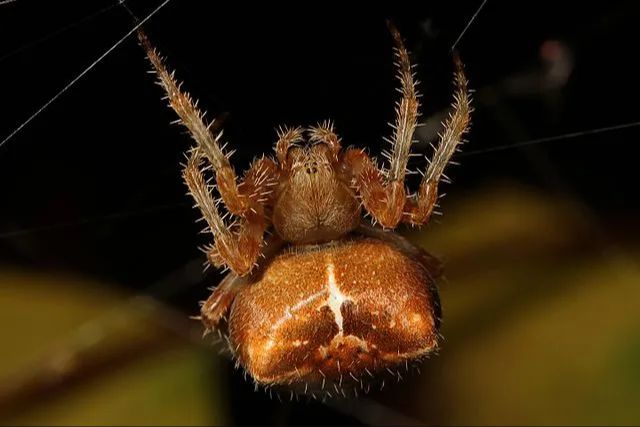What Are Cat Face Spiders?
Cat face spiders, scientifically known as Araneus gemmoides, are a species of orb-weaver spider found throughout North America. They get their common name from the unique markings on their abdomen that resemble a cat’s face, with “eyes,” “nose,” and “whiskers.”
These spiders have a round, bulbous abdomen and a small cephalothorax (head region). The abdomen is patterned with various shades of black, yellow, white, and orange, forming the “cat face.” They have eight eyes arranged in two rows. Their legs are banded with black and orange. Adult females range from 13-20mm in body length while males are smaller at 5-9mm.
Cat face spiders can be identified by their signature cat-like abdominal markings, orb-shaped webs, and banded leg pattern. They are not to be confused with spined micrathena spiders which have similar abdomen shapes but lack the distinctive “face.” https://a-z-animals.com/animals/cat-faced-spider/
Where Are Cat Face Spiders Found?
Cat face spiders are native to the United States and parts of Canada. Their range extends from southern Florida in the southeast all the way west to Utah, and north to southern Ontario and Quebec. The spiders are found primarily in the eastern and southeastern United States, including states like Florida, Georgia, North Carolina, Virginia, Maryland, New Jersey, New York, Ohio, Indiana, Illinois, and Missouri.

Cat face spiders thrive in wooded and forested areas and are commonly found in deciduous trees. They prefer establishing their webs on branches and leaves higher up off the ground. The spiders may also seek shelter under the loose bark of trees, rocks, logs, and man-made structures. You can find cat face spiders in urban and suburban settings inhabiting porches, sheds, garages, and eaves of homes where outdoor lighting attracts insects for them to prey upon.
According to sources, the range of the cat face spider extends approximately between 25°N and 47°N latitude across much of the eastern and central United States and adjacent southern Canada. The spider’s habitat range aligns closely with the deciduous and mixed forests found in this part of North America (Source).
Are Cat Face Spiders Dangerous?

Cat face spiders are not considered dangerously venomous to humans. According to the University of Florida’s Entomology and Nematology department, cat face spider bites may cause temporary redness and pain, similar to a bee sting, but are not medically significant [1]. The venom is designed to paralyze and kill insect prey rather than vertebrates like humans.
For cats and dogs, cat face spider bites can sometimes cause more severe reactions. According to Innovative Pest Solutions, cat face spider bites may result in lethargy, fever, visible bite marks, swelling, redness, and pain in pets [2]. Any concerning symptoms in pets after a potential spider bite should receive prompt veterinary attention.
If a human is bitten by a cat face spider, symptoms are generally mild. The bite may result in minor pain, redness, and irritation at the bite site. Rarely, bites can cause localized itching, muscle cramping, or swelling. Severe reactions are very uncommon. Bite symptoms usually resolve within a few hours, though pain may persist for up to a day.
How Do Cat Face Spiders Hunt?
Cat face spiders are voracious predators that use a variety of tactics to capture prey. They are clever web builders that construct intricate funnel-shaped webs to trap insects and other small invertebrates.
The webs of cat face spiders have a funnel-like shape, with the narrow end located in the spider’s retreat. The spider waits patiently here for vibrations that indicate prey has become ensnared. The wide end of the web can be several feet across and is often built in shrubs, overhanging vegetation, and between trees.
Cat face spiders do not rely solely on their webs to capture food. They will also actively hunt by stealthily stalking prey on foot. With excellent eyesight, cat face spiders are able to spot prey during the day or night from several inches away. They pounce quickly when within striking distance.
Some additional hunting tactics employed by cat face spiders include:
- Ambushing prey by waiting motionlessly for passing insects or other small invertebrates.
- Snatching prey directly from vegetation as they detect movements.
- Sensing vibrations through leaves, branches, and the ground to target prey.
Cat face spiders are voracious and opportunistic hunters. Their versatile hunting strategies and web-building capabilities make them effective predators of insects, spiders, and other small prey.
Reproduction and Life Cycle

The cat face spider reproduces once per year. After mating occurs in late summer, the female stores the male’s sperm in her spermathecae until she is ready to lay eggs [1]. She will produce an egg sac in autumn containing 100-200 eggs. The egg sac is carried beneath her body until the eggs hatch in spring [2].
After hatching from the egg sac, the spiderlings will climb onto their mother’s back and be carried for several days. Once they are ready, the young spiders will disperse and lead solitary lives. Cat face spiders typically live for 1-2 years. Males die shortly after mating while females may survive through the winter before laying their eggs.
Behavior and Interactions
Cat-faced spiders are generally nocturnal creatures who are active at night when hunting for food. They lead mostly solitary lives, with little interaction amongst each other outside of mating. These spiders do not live in colonies or groups.
Despite their somewhat frightening appearance, cat-faced spiders pose little threat to humans or pets. They tend to avoid contact when possible. Their bites are not considered medically significant, though they could cause mild pain or irritation [1]. Cat-faced spiders prefer to reside outdoors and are not typically found indoors.
These spiders build intricate webs in vegetation and trees in order to catch flying insect prey. Their webs may span several feet across. The webs generally do not pose a hazard for humans walking by, though they could accidentally walk through a web. The spiders themselves are unlikely to bite if disturbed in their web.
As solitary creatures that avoid human contact, cat-faced spiders do not require any control methods for households. Simply leaving them alone to reside outdoors is recommended. Their presence can help control insect populations in a yard or garden.
Bite Treatment and First Aid
If you suspect your cat has been bitten by a cat face spider, it’s important to seek medical attention right away as some spider bites can be dangerous. Bring your cat to the veterinarian as soon as possible so they can properly assess and treat the bite.
The vet will thoroughly examine the bite wound and look for signs of envenomation, which is when venom has entered the body. Symptoms may include swelling, redness, pain, and tissue damage around the bite. If envenomation is confirmed, the vet may administer antivenin medication, antibiotics, pain relievers, and other treatments as needed [1].
At home, carefully clean the wound with mild soap and water to prevent infection, but avoid using chemical disinfectants which can damage tissue. You can apply a cold compress to the bite area for 10-15 minutes several times a day to reduce pain and swelling[2]. Try to keep your cat from licking or scratching the bite wound so it can heal properly.
Monitor your cat closely over the next several days for any signs of worsening symptoms. Seek prompt veterinary care if you notice increased swelling, oozing, redness, or heat around the bite, as this may indicate a serious infection is developing.
With proper first aid and medical treatment, most cats recover well from spider bites. But quick action is essential, so don’t hesitate to call your vet if your pet has been bitten.
Prevention and Control
There are a few ways to help prevent cat-faced spiders from becoming a nuisance inside and around your home:

Reduce clutter and debris – Cat-faced spiders like to build their webs in undisturbed areas with lots of places to anchor their webs. Keeping your home tidy and free of clutter can help discourage them.
Seal cracks and crevices – Use caulk or sealant to close up any cracks or crevices on the exterior of your home that spiders may use to enter.
Install screens – Make sure windows and vents are properly screened to prevent spiders from crawling inside.
Use deterrents – Certain smells like peppermint, eucalyptus, citrus and vinegar can help repel spiders. Place cotton balls soaked in these solutions in corners, along baseboards and in other spider-prone areas (AZ Pest).
Remove webs – Regularly knock down any webs you see both inside and outside your home to discourage spiders from sticking around.
Use insecticides – Outdoor barrier sprays or targeted sprays into cracks and crevices where you see spider activity can help control populations. Consult a pest control professional for products approved for spider control.
Encourage natural predators – Spiders like wolf spiders, crab spiders and jumping spiders will prey on cat-faced spiders and can help keep populations in check.
Pets and Cat Face Spiders
Cat face spiders are generally not considered a major risk to household pets like cats and dogs. However, they can bite pets if threatened or accidentally touched. According to the Cat Faced Spider: All You Need to Know in a Nutshell article on WhatsThatBug.com, cat faced spiders “generally do not pose a significant threat to humans or pets, as they are not known to be highly venomous.”
That said, some pets may experience mild symptoms if bitten, like itching, redness or swelling around the bite area. The venom is not potent enough to cause serious illness in most pets. Larger animals like dogs are even less likely to have a significant reaction. The bite may be painful but the venom will not endanger your pet’s life.
To prevent bites, keep pets away from areas where you find cat face spider webs, like in garages, sheds, wood piles, beneath outdoor furniture, etc. Supervise outdoor playtime and walks so you can promptly remove any webs your pet encounters. You can also remove webs around your property regularly to reduce the local spider population. Check your pet’s body thoroughly after going outside to ensure no spiders hitched a ride inside.
If your pet is bitten, clean the wound and apply a cold compress to relieve swelling. Give them a Benadryl if there is a lot of itching or irritation from the bite. Call your vet if symptoms seem severe or persist more than a day or so. With prompt care, your pet should recover fully within a short time.
Frequently Asked Questions
Here are some common queries and concerns regarding cat face spiders:
Are cat face spiders poisonous or venomous?
No, cat face spiders are not considered dangerous to humans. They have small fangs and venom that is not medically significant. Bites may cause a mild irritation but are harmless overall (WSU Department of Entomology).
What does a cat face spider bite feel like?
The bite of a cat face spider resembles a pinprick and results in mild pain, redness, and itching near the bite site. The bite may feel similar to a mosquito or flea bite (WSU Department of Entomology).
Are cat face spiders aggressive?
No, cat face spiders are not aggressive toward humans. They may bite only if carelessly handled or trapped against bare skin. Overall they are docile and unlikely to bite (WSU Department of Entomology).
Should I kill cat face spiders on my property?
Cat face spiders are harmless and help control insect pests. It is not necessary to kill them. Safely relocating them outside is recommended if they are unwanted inside the home (WSU Department of Entomology).
How big do cat face spiders get?
The body size of adult cat face spiders ranges from roughly 1/2 inch to 1 inch (12-25 mm). Their legspan can reach 2-3 inches (5-7 cm) across (WSU Department of Entomology).
